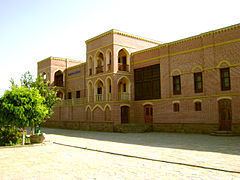Languages Persian (official), Disestablished 1828 Founded 1747 Political structure Khanate | Established 1747 Preceded by Succeeded by Capital Nakhchivan | |
 | ||
Nakhichevan khanate
The Nakhchivan Khanate (Persian: خانات نخجوان — Khānāt-e Nakhchevān) was a khanate that was established in Safavid Persia in 1747. The territory of the khanate corresponded to most of the present-day Nakhchivan Autonomous Republic and Vayots Dzor Province of present-day Armenia. It was named after its chief settlement, the town of Nakhchivan.
Contents
History
Initially the territory of Nakhchivan was part of the Erivan Khanate, but later came to be ruled by a separate khan. Shortly after the capture of Yerevan in 1604, Shah Abbas I appointed the first governor of Nakhichevan: Maqsud Sultan, a leader of a Turkic tribe named Kangarlu, who were described by J. M. Jouannin as “a small tribe established in Persian Armenia on the shores of the Aras". Later that year, as Ottoman forces threatened the area during the Ottoman-Safavid War of 1603-1618, Shah Abbas ordered Maqsud Sultan to evacuate the entire population of the Nakhchivan region (including the Armenians of Jolfa, who, in the following year, were transplanted to Isfahan) to Qaraja Dag (Arasbaran) and Dezmar. Persian rule was interrupted by Ottoman occupation between 1635-1636 and 1722-1736. It officially became a full functioning khanate during the Afsharid Dynasty.
During the Russo-Persian War of 1804-1813, in 1808 Russian forces under general Gudovich briefly occupied Nakhchivan, but as a result of the Treaty of Gulistan it was returned to Persian control.
During the Russo-Persian War of 1826-1828, in 1827 Abbas Mirza appointed Ehsan Khan Kangarlu as commander of Abbasabad, a fortress of strategic importance for the defense of the Nakhchivan khanate. After heavy losses in an attempt to take the fortress by escalade on July 14, the Russians mounted a siege. Ehsan Khan secretly contacted the Russian commander, General Paskevich, and opened the gates of the fortress to him on 22 July 1827. With the Treaty of Turkmenchay, in 1828 the khanate became a Russian possession and Ehsan Khan was rewarded with the governorship, conferred the rank of major-general of the Russian army and the title of campaign ataman of the Kangarlu militia.
The abolition of the khanate
In 1828 the khanates of Erivan and Nakhchivan were dissolved and their territories united to form the Armenian Oblast ("Armianskaia Oblast"). In 1840 that province was dissolved and its territory incorporated into a larger new province, the Georgia-Imeretia Governorate ("Gruziia-Imeretiia"). This new division did not last long – in 1845 a vast new territory called the Caucasian Territory ("Kavkazskii Krai") or Caucasian Viceregency ("Kavkazskoe Namestnichestvo") was created, in which the former Armenian Province formed part of a subdivision named the Tiflis Governorate. In 1849 the Erivan Governorate was established, separate from the Tiflis Governorate. It included the territory of the former Nakhchivan khanate, which became the province's Nakhchivan uyezd.
After the dissolution, the khans of Nakhchivan took the Russified surname Khan Nakhchivanski, and the men of its family traditionally entered the Russian public services, chiefly the army. The family remained very wealthy, were the biggest landowners in the district, and continued to exercise enormous influence over the rest of the Muslim community. Six Khans Nakhchivanski became generals in the Russian tsarist, Soviet and Iranian armies.
Two sons of Ehsan khan - Ismail khan and Kalbali khan - were generals in the Russian army and were awarded orders of Saint-George IV degree for their actions in battle. A son of Kalbali khan, Huseyn Khan Nakhichevanski, was a prominent Russian military commander and adjutant general of the Russian Emperor, and his nephews, Jamshid Khan and Kalbali, were generals in the Soviet and Iranian armies respectively.
Rulers
The rulers were:
